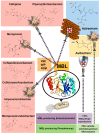The Revival of Aztreonam in Combination with Avibactam against Metallo-β-Lactamase-Producing Gram-Negatives: A Systematic Review of In Vitro Studies and Clinical Cases
- PMID: 34439062
- PMCID: PMC8388901
- DOI: 10.3390/antibiotics10081012
The Revival of Aztreonam in Combination with Avibactam against Metallo-β-Lactamase-Producing Gram-Negatives: A Systematic Review of In Vitro Studies and Clinical Cases
Abstract
Infections caused by metallo-β-lactamase (MBL)-producing Enterobacterales and Pseudomonas are increasingly reported worldwide and are usually associated with high mortality rates (>30%). Neither standard therapy nor consensus for the management of these infections exist. Aztreonam, an old β-lactam antibiotic, is not hydrolyzed by MBLs. However, since many MBL-producing strains co-produce enzymes that could hydrolyze aztreonam (e.g., AmpC, ESBL), a robust β-lactamase inhibitor such as avibactam could be given as a partner drug. We performed a systematic review including 35 in vitro and 18 in vivo studies on the combination aztreonam + avibactam for infections sustained by MBL-producing Gram-negatives. In vitro data on 2209 Gram-negatives were available, showing the high antimicrobial activity of aztreonam (MIC ≤ 4 mg/L when combined with avibactam) in 80% of MBL-producing Enterobacterales, 85% of Stenotrophomonas and 6% of MBL-producing Pseudomonas. Clinical data were available for 94 patients: 83% of them had bloodstream infections. Clinical resolution within 30 days was reported in 80% of infected patients. Analyzing only patients with bloodstream infections (64 patients), death occurred in 19% of patients treated with aztreonam + ceftazidime/avibactam. The combination aztreonam + avibactam appears to be a promising option against MBL-producing bacteria (especially Enterobacterales, much less for Pseudomonas) while waiting for new antimicrobials.
Keywords: Enterobacterales; Pseudomonas; Stenotrophomonas; antibiotic combination; avibactam; aztreonam; ceftazidime/avibactam; last resource antibiotic; metallo-β-lactamase; old antibiotic.
Conflict of interest statement
All the authors declare no conflict of interest.
Figures



References
-
- Snyder B.M., Montague B.T., Anandan S., Madabhushi A.G., Pragasam A.K., Verghese V.P., Balaji V., Simões E.A.F. Risk factors and epidemiologic predictors of bloodstream infections with New Delhi metallo-β-lactamase (NDM-1) producing Enterobacteriaceae. Epidemiol. Infect. 2019;147:1–9. doi: 10.1017/S0950268819000256. - DOI - PMC - PubMed
-
- Falcone M., Tiseo G., Antonelli A., Giordano C., Di Pilato V., Bertolucci P., Parisio E.M., Leonildi A., Aiezza N., Baccani I., et al. Clinical features and outcomes of bloodstream infections caused by New Delhi metallo-β-lactamase-producing Enterobacterales during a regional outbreak. Open Forum Infect. Dis. 2020;7:1–5. doi: 10.1093/ofid/ofaa011. - DOI - PMC - PubMed
-
- Spyropoulou A., Bartzavali C., Vamvakopoulou S., Marangos M., Anastassiou E.D., Spiliopoulou I., Christofidou M. The first NDM metallo-β-lactamase producing Klebsiella pneumoniae isolate in a university hospital of southwestern Greece. J. Chemother. 2016;28:350–351. doi: 10.1179/1973947815Y.0000000003. - DOI - PubMed
Publication types
LinkOut - more resources
Full Text Sources
Miscellaneous

